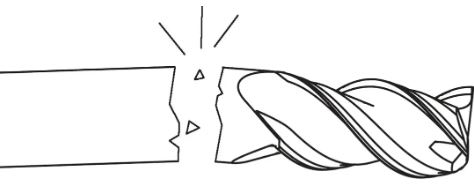Carbide endmills are essential tools in machining processes, offering superior durability and performance. However, even these robust tools can occasionally succumb to breakage. Understanding the reasons behind carbide endmill breakage is crucial for machinists and manufacturers seeking to optimize tool life, reduce downtime, and enhance productivity. In this article, we explore the most probable causes of carbide endmill breakage, shedding light on factors that may impact their longevity.

Excessive Cutting Forces
One of the primary reasons for carbide endmill breakage is excessive cutting forces. These forces can arise from various factors, such as improper feeds and speeds, inappropriate tool geometry, or insufficient rigidity of the machining setup. When the cutting forces exceed the endmill's structural limits, it can result in chipping or catastrophic failure.
To mitigate this issue, machinists should carefully calculate and apply appropriate cutting parameters, ensuring they align with the endmill's specifications. Balancing the feed rate, spindle speed, depth of cut, and stepover is crucial to prevent excessive forces that can lead to endmill breakage.
Improper Tool Selection
Selecting the right carbide endmill for a specific machining operation is critical. Different materials, cutting conditions, and machining strategies demand specific tool geometries, coatings, and designs. Using an incorrect endmill can result in accelerated wear, excessive heat buildup, and ultimately, tool failure.
Machinists should consider factors such as material type, hardness, and cutting conditions when choosing the appropriate endmill. Factors like flute count, helix angle, coating type, and tool diameter play significant roles in determining the tool's suitability for a given application. Proper tool selection enhances tool life and reduces the risk of endmill breakage.
Inadequate Coolant or Lubrication
Insufficient coolant or lubrication during the machining process can generate excessive heat, causing the carbide endmill to overheat. High temperatures can lead to thermal cracking, softening of the carbide material, and ultimately, breakage.
Applying an appropriate coolant or lubricant helps dissipate heat, reduces friction, and improves chip evacuation. Machinists should ensure the coolant flow, concentration, and method of application are optimized for the specific material and machining conditions. Sufficient cooling and lubrication can significantly extend the life of carbide endmills.
Workpiece Material Issues
Certain workpiece materials pose challenges to the longevity of carbide endmills. Abrasive materials, such as hardened steels, cast iron, or composites, can accelerate tool wear and increase the likelihood of breakage.
When machining abrasive materials, machinists should select endmills with specialized coatings, such as TiAlN or TiCN, to enhance wear resistance. Additionally, reducing cutting parameters, employing trochoidal milling techniques, or implementing advanced tool path strategies can alleviate the stress on the endmill, minimizing the risk of breakage.
Tool Defects or Wear
Even with proper care and maintenance, carbide endmills can develop defects or wear over time. Microscopic cracks, tool runout, or edge chipping can compromise the structural integrity, leading to premature breakage.
Regular inspection and monitoring of endmills are essential to identify signs of wear or damage. Periodic replacement or resharpening can prevent catastrophic failure and ensure consistent performance.
Carbide endmill breakage can hinder machining operations, resulting in downtime, increased costs, and compromised product quality. By understanding the most probable causes of breakage, machinists can take proactive measures to optimize cutting conditions, select appropriate tools, implement effective cooling strategies, and mitigate material-related challenges. By prioritizing proper tool selection, maintenance, and process optimization, manufacturers can maximize the lifespan of carbide endmills, boosting productivity and achieving superior machining outcomes.
